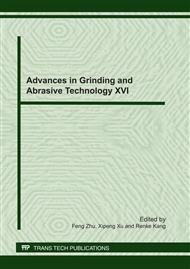p.1
p.6
p.11
p.16
p.24
p.29
p.34
p.39
The Study of Wear Flat Effect on the Single Grain Micro-Cutting Performance in Superabrasive Grinding from a Simulation Perspective
Abstract:
Grain-workpiece interface, which resembles a micro-cutting process, directly modifies the workpiece surface and dominates all the output measures of a grinding process. The abrasive grains always become worn or dulled during grinding, which alters the grain-workpiece interface output and turns to be the primary factor that causes the transient or time dependent behavior in monolayer superabrasive grinding. Therefore, the study on how the grain wear influences the grain-workpiece interaction through micro-cutting analysis becomes necessary. As the emergence of the packaged FEM software for micro-cutting simulation, apart from single grit cutting test, it enables another qualitative and quantitative investigation method on grain-workpiece interface mechanism in an efficiency and effective manner. Based on previous efficacy verification of Third Wave AdvantEdgeTM, the FEM simulation is carried out to investigate the effect of grain wear on its micro-cutting performance. The simulation results provide an illustrative manner to interpret the phenomenon and mechanism, and the results can be used in the grinding process modeling in the future as well.
Info:
Periodical:
Pages:
11-15
Citation:
Online since:
July 2011
Authors:
Keywords:
Price:
Сopyright:
© 2011 Trans Tech Publications Ltd. All Rights Reserved
Share:
Citation:


